Karaage (Japanese Fried Chicken) is easily one of the greatest types of fried chicken in the world. It’s exceptionally flavorful, juicy, ultra-crispy, and absolutely worth hanging out at the stove for! Learn the simple techniques and fry up some glorious chicken at home today.
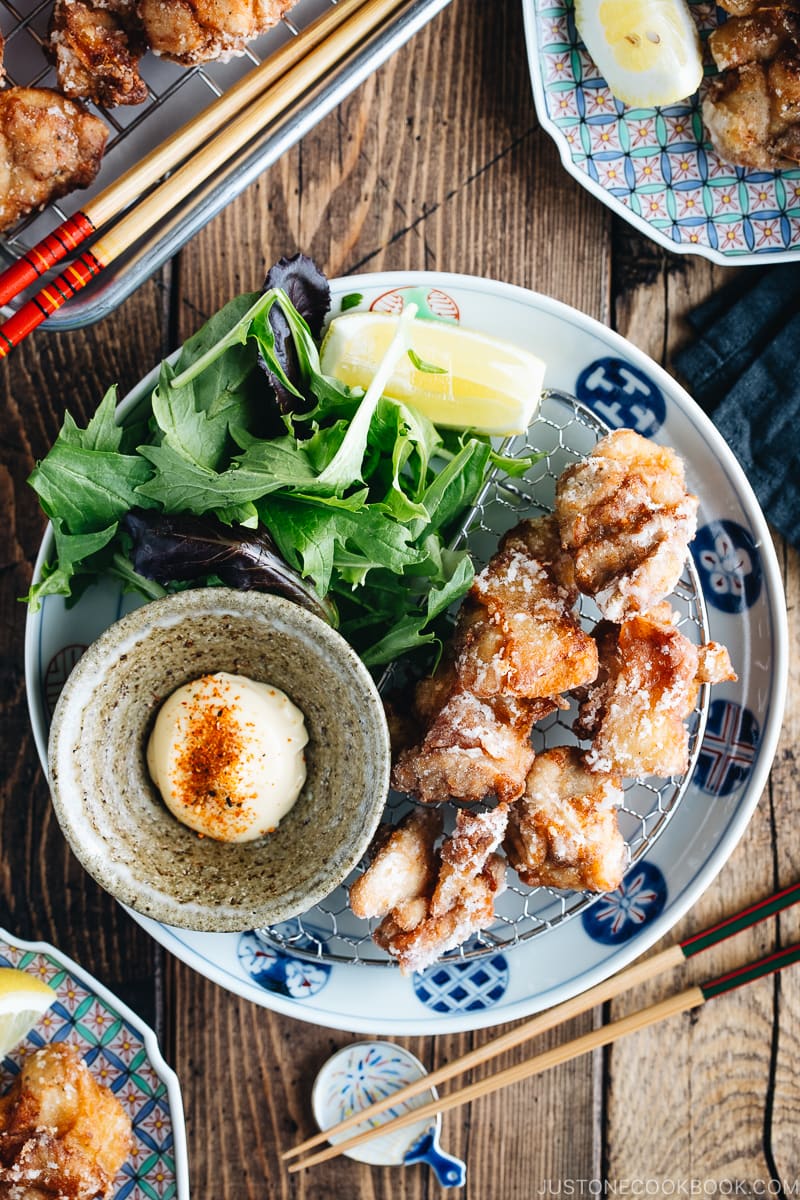
Karaage (唐揚げ), or Japanese fried chicken, is a classic dish you can find at any Japanese home, bento lunch box, street-side stalls, restaurants, or diners. Come in bite-size nuggets, anyone who has tried the fried chicken can tell you how deliciously addicting it can be.
I grew up eating a countless number of karaage, and mom’s version was always the best. Just like any Japanese home cook in her generation, mom never shied away from deep frying, especially when it comes to a dish worthy to make for the family. The chicken always turned out with cracker-crisp skin and the meat absolutely something you want to indulge with great abandon. Thanks to mom, I’m able to share the fried chicken love with you. And I promise: it’s going to be really good!
What is Karaage?
Pronounced as ‘ka-RA-AH-geh’, the word karaage refers to a Japanese cooking technique in which an ingredient is lightly coated with flour and deep-fried in oil. When you hear “karaage”, most of us assume it’s chicken karaage, but it can also be fish or vegetables.
For chicken karaage, it’s essentially bite-size pieces of chicken thigh dusted with flour and deep-fried in hot oil. With tender and juicy marinated chicken coated in a crispy shell, karaage is a staple in Japanese home-cooked meals.
You may find this delicious Japanese fried chicken being served at:
- home – it can be a main dish or appetizer.
- diner and restaurant – karaage teishoku is a popular set meal.
- Izakaya and bar – served as an appetizer to go with a drink.
- supermarket, convenience store, and depachika (B1F – the gourmet food galore in the basement of a department store).
- bento shop – karaage bento is a popular choice
Frequently Asked Questions
What is the difference between karaage and katsu?
Katsu refers to deep-fried cutlet and commonly uses chicken breast that’s been breaded with panko before frying, while karaage uses bite-size chicken thighs that are coated potato or corn starch. We serve katsu with a sweet-savory brown sauce called tonkatsu sauce. For karaage, we usually serve it with Japanese mayonnaise and a squeeze of lemon juice.
How about tatsutaage?
Tatsutaage (竜田揚げ) is another dish that is similar to karaage. The chicken is marinated in soy sauce and mirin, coated with potato starch (katakuriko), and then deep-fried till golden brown.
Wait, isn’t it almost identical to Karaage?
As mentioned earlier, karaage originally implies that the food was simply coated with flour and then deep-fried. There was no marinating involved. However, in recent years, the Japanese use these terms interchangeably. Karaage has more variations when it comes to seasonings and a lot more flexibility in how it’s being prepared, while tatsutaage has a signature method to go by.
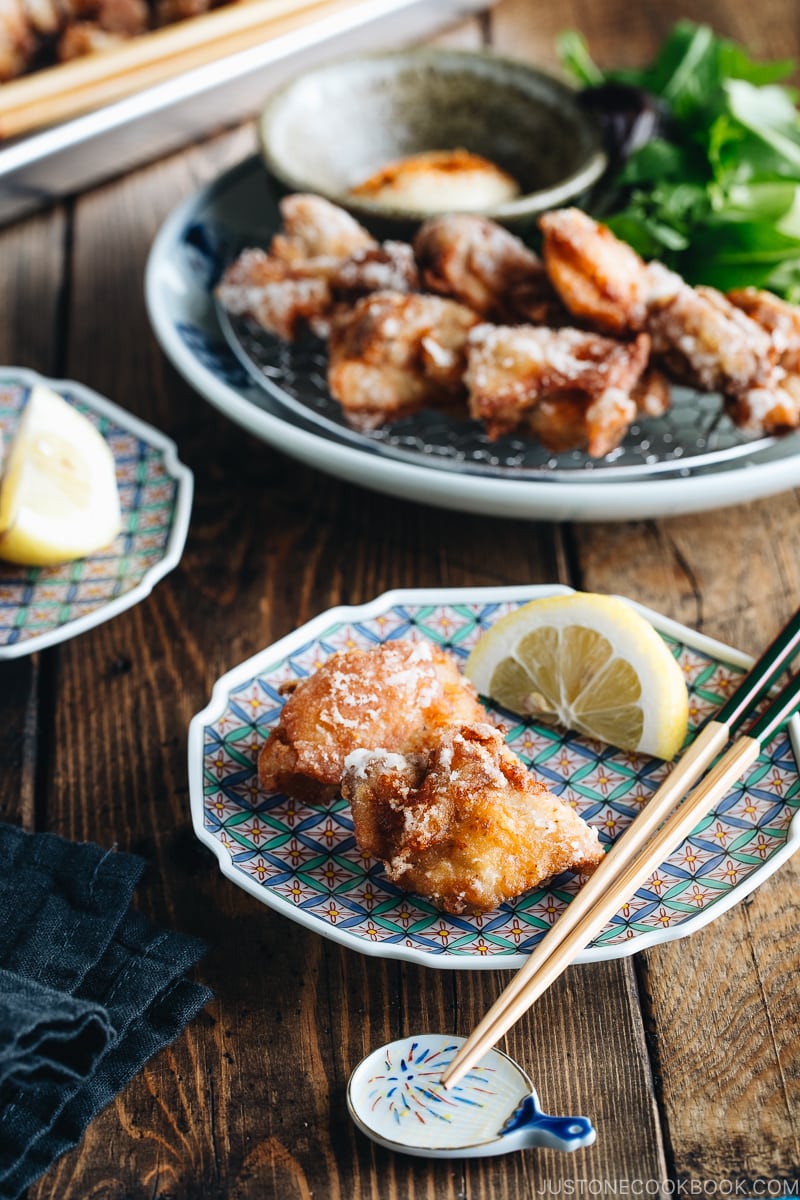
4 Key Ingredients for Karaage
1. Chicken
In Japan, karaage is typically made with skin-on boneless chicken thighs, which has more flavor than chicken breasts. However, if you really want to use breasts, that’s okay.
Here in the US, skin-on chicken thighs are always sold with bones. To save time, I usually ask my friendly butcher to remove the bones for me. Why do we need to use skin-on? The skin keeps the karaage crispy on the outside and the meat juicy inside.
2. Marinade/Seasonings
There are so many variations of marinade/seasonings available for Karaage, and this is really up to you. I make mine slightly different all the time. However, the primary base should always include soy sauce, sake, and ginger.
Sake helps tenderize the meat while ginger gives zing and removes the gamey taste.
Some variations for the seasonings include:
- garlic
- sesame oil
- mirin
- oyster sauce
- curry powder
- egg yolk
- Japanese mayonnaise (I haven’t tried it…)
Feel free to experiment with the ingredients and see what you like!
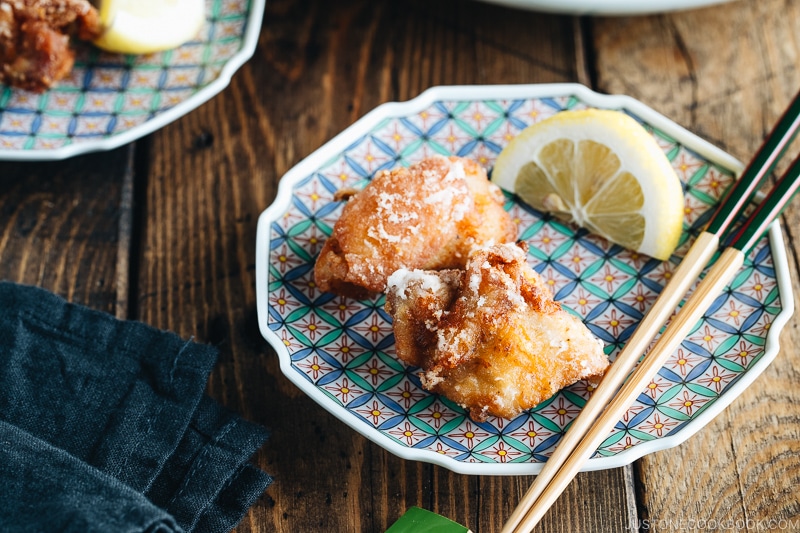
3. Coating
This is another flexibility you can work with by testing out different ratios:
- Flour – you can decide cake flour (lighter shell) or all-purpose flour (easily available in the US)
- Potato starch
- Flour + potato starch
- Rice flour + potato starch (see this recipe) – this is gluten-free!
In this recipe, I use equal parts of all-purpose flour and potato starch. I first dredge the chicken in flour and then potato starch. The flour will trap the marinade and seasonings inside the shell, and potato starch will create a crisp texture on the outside. You can premix the flour and starch, but I actually like dredging in 2 stages for the best result!
Potato starch vs. Corn starch
In Japan, potato starch (or katakuriko 片栗粉) is most commonly used as a coating for frying foods. Here in the US, corn starch is much easier to access in regular grocery stores, so that is a close substitute if you have trouble finding potato starch.
As a comparison, I found that karaage made with potato starch yields a crispier skin and texture. If you compare these two starches by rubbing them between your fingertips, you will notice the difference.
Potato starch is available on Amazon and larger grocery stores. I think it’s worth looking for it to make delicious Karaage.
Are potato starch and potato flour the same?
No, they are not the same. Potato starch is made from the dried starch component of peeled potatoes while potato flour is made from whole (raw or cooked) potatoes being dried then ground into flour.
4. Deep-Frying Oil
My recommendation for deep frying oil includes:
- Canola oil (キャノーラ油)
- Safflower oil (べに花油)
- Rice bran oil (米油)
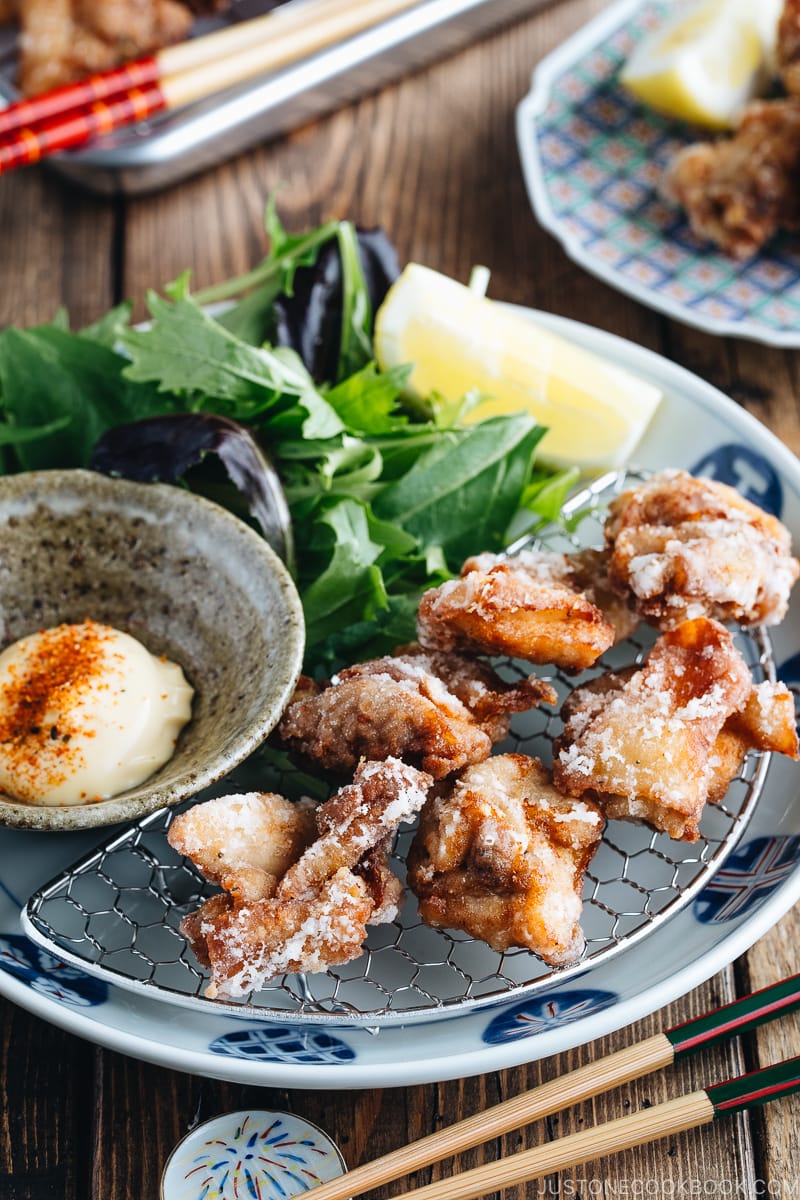
4 Helpful Tips to Remember
- Cut the chicken into same size pieces – It’s very important that each chicken is similar in sizes so you can cook evenly.
- Don’t marinate too long! – 30 minutes is ideal for the chicken to soak in the flavors.
- Lightly coat the chicken. – Remove the excess flour. It will make the oil cloudy and doesn’t give a good texture to the chicken.
- Double fry! – Fry at a lower temperature first, let it cook with remaining heat, and lastly make it crisp at the higher temperature.
Because they are bite-size, Karaage is utterly doable at home. It may require some extra oil, but you know you would be dishing out some glorious fried chicken at home!
More Chicken Recipes on Just One Cookbook
- Karaage Don (Karaage Rice Bowl)
- Nagoya Style Fried Chicken Wings
- Chicken Karaage with Sweet Chili Sauce
- Gluten-Free Karaage
- Teba Shio (Salted Chicken Wings)
- Baked Chicken Katsu
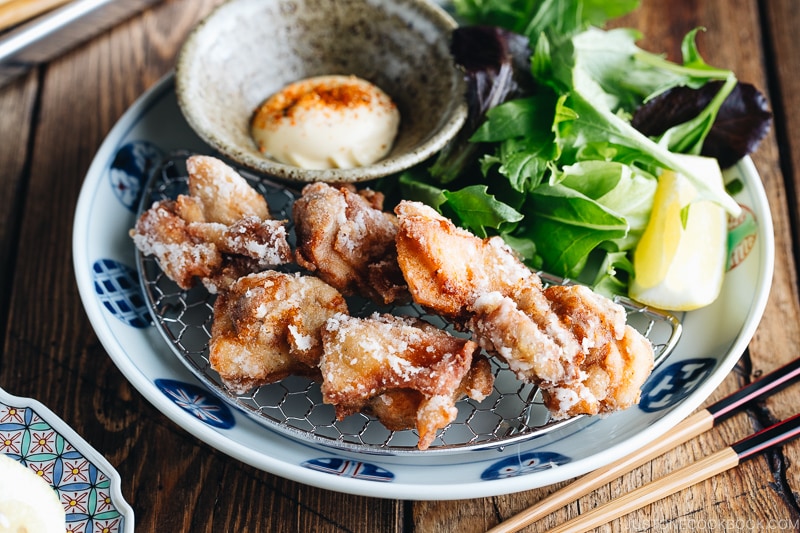
Wish to learn more about Japanese cooking? Sign up for our free newsletter to receive cooking tips & recipe updates! And stay in touch with me on Facebook, Pinterest, YouTube, and Instagram.
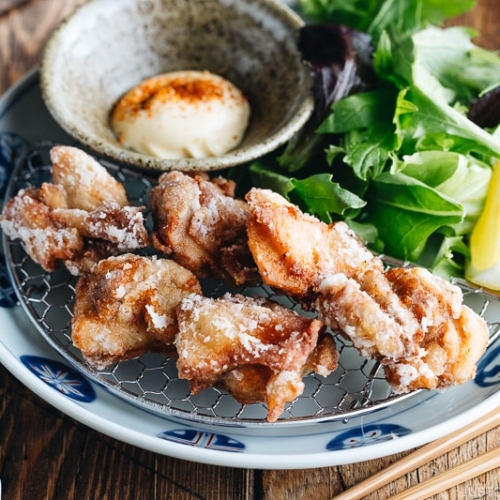
Karaage (Japanese Fried Chicken)
Video
Ingredients
- 1½ lb boneless, skin-on chicken thighs (4–6 pieces; read the blog post)
- ½ tsp Diamond Crystal kosher salt
- freshly ground black pepper
For the Marinade
- ½ tsp ginger (grated, with juice)
- 1 clove garlic
- ½ Tbsp soy sauce
- ½ Tbsp sake (or substitute with dry sherry, Chinese rice wine, or omit)
- ½ tsp toasted sesame oil
For Deep-Frying
- neutral oil (about 4 cups, 960 ml)
- 2 Tbsp potato starch or cornstarch (plus more, if needed)
- 2 Tbsp all-purpose flour (plain flour) (plus more, if needed)
For Serving (optional)
Instructions
- Gather all the ingredients.

To Marinade the Chicken
- To prepare 1½ lb boneless, skin-on chicken thighs, cut each chicken thigh into 2-inch (5-cm) pieces. Season with ½ tsp Diamond Crystal kosher salt and freshly ground black pepper.

- Now, grate the ginger (I use a ceramic grater). Take ½ tsp ginger (grated, with juice) and add them to a large bowl. Next, mince or press 1 clove garlic (I use a garlic press) and add it to the bowl.

- Add ½ Tbsp soy sauce, ½ Tbsp sake, and ½ tsp toasted sesame oil to the bowl with the ginger and garlic. Whisk it all together.

- Add the chicken to the bowl with the marinade and mix it with your hands. Cover and keep in the refrigerator to marinate for 30 minutes.

To Prepare the Deep Frying Oil
- While the chicken is marinating, prepare the oil for deep-frying. Pour about 4 cups (960 ml) neutral oil into a heavy-bottomed pot (I used a Dutch oven) and heat it to 325ºF (160ºC) on medium heat.

To Dredge the Chicken
- While the oil is heating up, dredge the chicken. Prepare 2 Tbsp all-purpose flour (plain flour) and 2 Tbsp potato starch or cornstarch in separate piles.

- Lightly dredge a marinated chicken piece in the flour and dust off the excess flour. Then, dredge in the potato starch and remove the excess starch.

- Continue with the remaining chicken pieces.

To Deep-Fry
- Check that the oil temperature has reached 325ºF (160ºC). Tip: If you don‘t have an instant read thermometer, insert a wooden chopstick into the oil; you‘ll know it‘s hot enough if small bubbles start to appear around the tip. For more details, see my post How to Deep-Fry Food.When the oil is hot enough, gently submerge 3 to 5 chicken pieces in the oil at a time; do not overcrowd the pot. Tip: If you put too many pieces in at once, the oil temperature will drop quickly, and the chicken will end up absorbing too much oil.

- First Deep-Frying: Deep-fry for 90 seconds, or until the outside of the chicken is a light golden color. If the chicken browns too quickly, then the oil temperature is too high. Either put a few more pieces of chicken in the oil or lower the heat. Controlling the oil temperature at all times is very important for deep-frying. Transfer the chicken pieces to a wire rack to drain the excess oil.

- The residual heat will continue to cook the chicken as it rests on the wire rack. Continue deep-frying the remaining chicken pieces. Between batches, pick up and discard the crumbs in the oil with a fine-mesh sieve. This keeps the oil clean and prevents it from becoming darker.

- Second Deep-Frying: Now, heat the oil to 350ºF (180ºC). Place 3 to 5 pieces of the resting chicken back into the oil and deep-fry for 45 seconds, or until the skin is golden brown and crispy. Transfer them to a wire rack to drain the excess oil. Continue with the remaining chicken pieces.

- The left photo shows the chicken pieces after the first frying and the right photo shows them after the second frying. You can see the chicken pieces on the right are slightly darker in color.

To Serve
- Serve the chicken hot. We often serve Karaage with lemon wedges and dip it in Japanese Kewpie mayonnaise (you can make it homemade). Sprinkle shichimi togarashi (Japanese seven spice) on top for a bit of spice, if desired.

To Store
- Let cool completely, and keep in an airtight container. You can store it in the refrigerator for up to 3 days and in the freezer for up to a month.
Nutrition
Editor’s Note: This post was originally published on October 10, 2012. The new video is added and the images have been updated in October 2019.
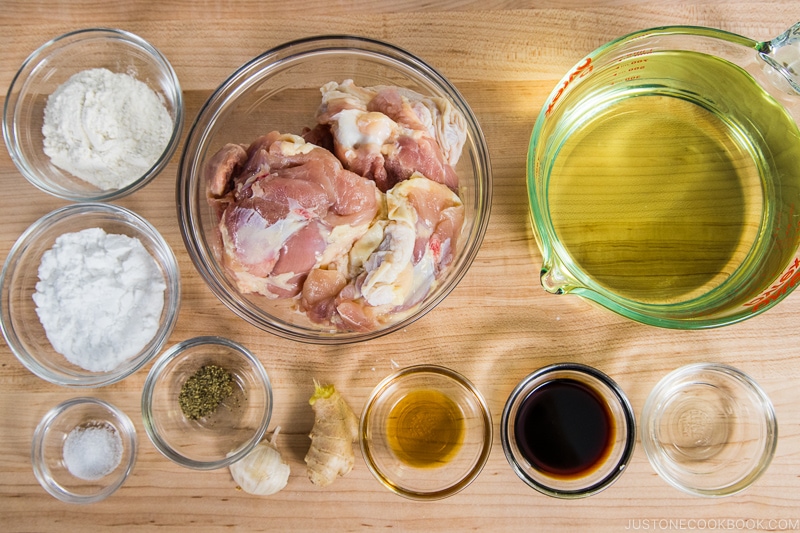
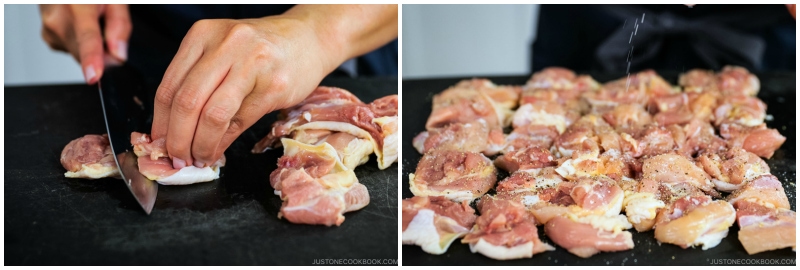
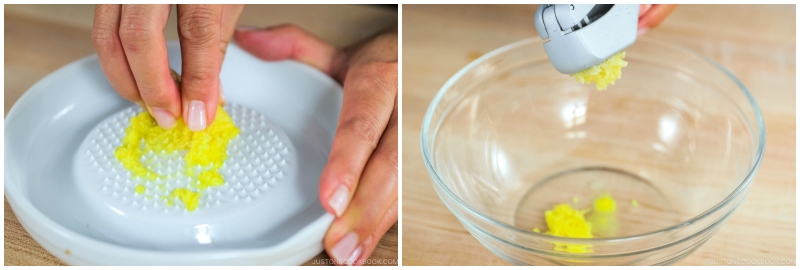


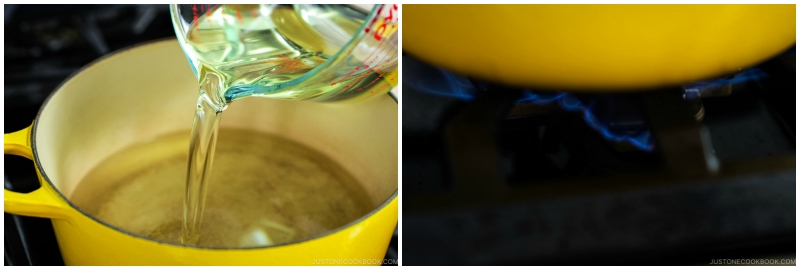
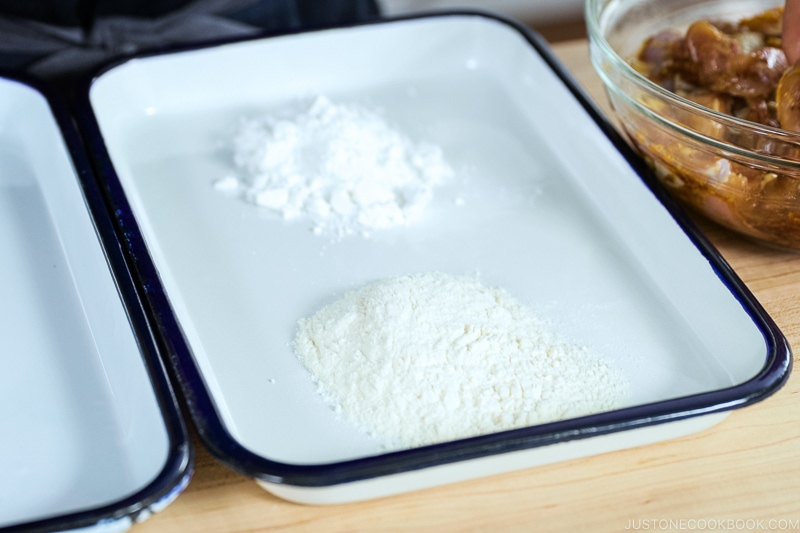

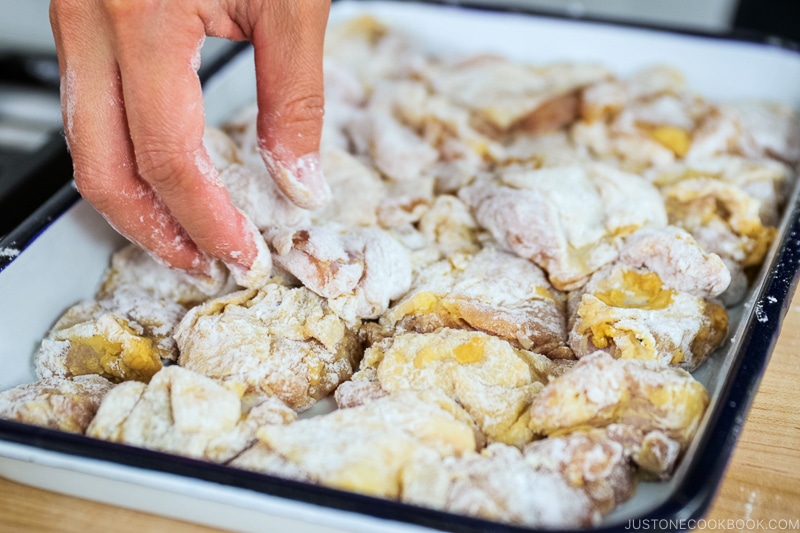
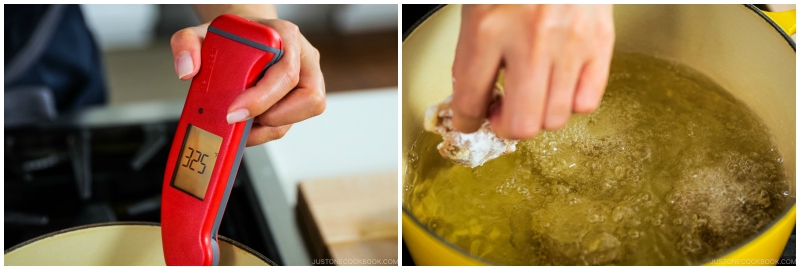
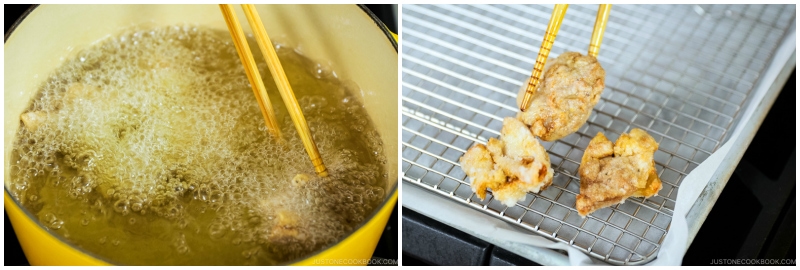
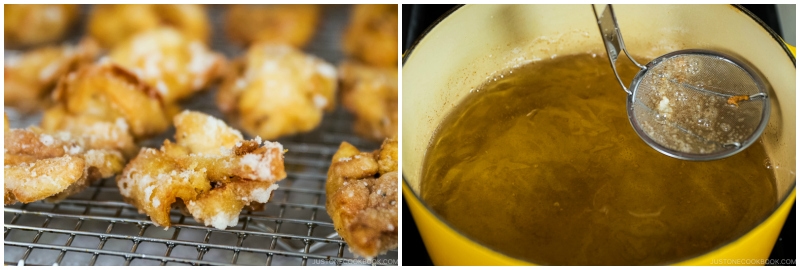
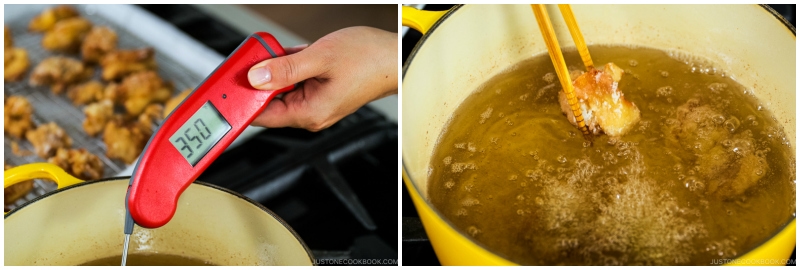
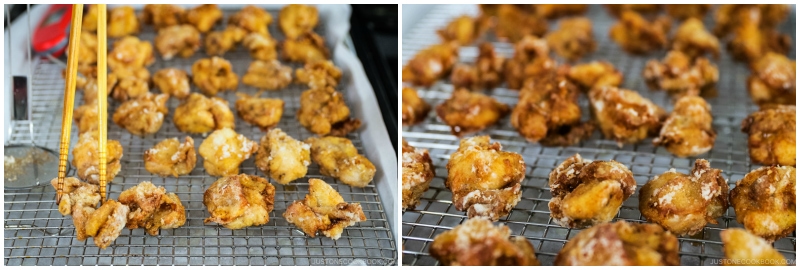












How might this be converted for air fryers (I’m a noob with them)?
Hi there! Thank you for taking the time to read Nami’s post!
We’ve never tried this recipe in an air fryer, but our readers say it works!
They recommend cooking Karaage for approximately 7 minutes at 390 degrees, flipping it, and cooking for another 6 minutes.
If you give it a try, please let us know how it goes!
this was pretty easy and yummy! i can see why it’s a popular item in bento boxes 🙂
Hi Aiman! We are glad to hear you liked Karaage!
Thank you so much for trying Nami’s recipe and for your kind feedback!
Happy Bento! 😁🫶🏻
Hello Namiko-san, Naomi-san! In your karaage rice recipe (https://www.justonecookbook.com/chinese-style-karaage-don/) you combine the flour and cornstarch dredge. Any reason why we can’t do the same here?
Thank you!
Hello, Ioannis. Thank you for trying Nami’s recipe.
Nami explained why she didn’t mix them up in her post. We hope this helps and makes sense! Happy cooking!🫶🏻
I want to make this, but I am afraid of deep frying (and don’t know what to do with the oil afterwards) — can I bake this in the toaster oven?
Hi, Claire! Thank you for reading Nami’s post.
We’ve never baked this Karaage before, so we’re not sure how it’ll turn out, but it should work!
If you’re new to deep frying, we suggest reading this post.🤗
https://www.justonecookbook.com/how-to-deep-fry-food/
We hope this helps!
Thank you, Naomi! Maybe Nami-san will experiment with baked Karaage in the future. Thank you for replying to my comment.
You are very welcome, Claire!🤗
Hi! I’ve made this lots and it’s delicious!!!
Could I ask please…is it possible to make it with pre cooked chicken pieces?
Hello, Anna. We’re glad you enjoyed Nami’s recipe.
We highly recommend following the recipe for the juicy Karaage. However, you can use pre-cooked chicken. Please adjust the cooking time so that the meat does not overcook.
We hope this was helpful!
Nami!!! I just made this tonight and I couldn’t believe how good it came out! I’ve never deep fried anything before in my life (frying scares me lol) but it came out better than I could have dreamed. My husband is already asking me when I’m making it again. Thank you for yet another amazing recipe!
Hello, Lisa! We are thrilled to hear you enjoyed our homemade Karaage!
Here is some guidance for those new to deep-frying. We hope this helps!
https://www.justonecookbook.com/how-to-deep-fry-food/
Another delicious recipe from Nami San
Hi Matt! Aww. We are glad to hear you enjoyed Nami’s Karaage recipe!
Thank you very much for your kind feedback. Happy Cooking!
Can I make this using air fryer?
Hi Emi! Thank you for taking the time to read Nami’s post!
We’ve never tried this recipe in an air fryer, but our readers say it works!
They recommend cooking Karaage for approximately 7 minutes at 390 degrees, flipping it, and cooking for another 6 minutes.
We hope this was helpful!
I made this recipe and is my first time participating in a JOC Cooking Challenge.
Although I’ve done a lot Japanese cooking before, I’ve never made karaage before. I think turned out pretty good, but there was perhaps a little too much residual starch before frying. I tried to follow the recipe as close as possible, but used shredded cabbage instead of mixed greens.
Thank you for hosting the cooking challenge, I look forward to future events!
Hi T J! Thank you so much for participating in a cooking challenge and sharing your Karaage photo with us! It looks so delicious!
Yes. It’s a quarterly online event on Just One Cookbook. So please keep an eye out for the next challenge.
https://www.justonecookbook.com/joc-cooking-challenge/
Happy Cooking!
My first JOC Cooking Challenge entry. Karaage chicken served with spinach shiraai, potato macaroni salad, rice and tsukemono. Thank you for the recipe!
Hello, Denise! Wow!😍 Thank you for trying Nami’s recipes and sharing a photo of your meal with us! That looks fabulous!
We wish you all the best with the cooking challenge! Happy cooking!
My family always loves japanese fried chicken, and I am pleasantly surprised that it is easy to make at home. Thank you JOC!
Hi Ailina! Aww😍, It is a very nice photo of your meal! Thank you so much for trying Nami’s recipe and sharing it with us.
It made us so happy to hear that your family enjoyed Karaage! Happy Cooking.
After making this it has now become a family favorite. It was very easy and super delicious.
Hi Dawn! Aww☺️ We are so happy to hear this become your family favorite.❤️
Thank you so much for trying Nami’s recipe and for sharing the Karaage photo with us.
Happy Cooking!
I always do this recipe for my wife. She like it so much!
This time I did to participate in March 2023 JOC Cooking Challenge.
Thank you Nami for this recipe!
Hi Felipe! Thank you so much for trying Nami’s recipe and sharing the Karaage photo with us!
That looks very amazing! We wish you the best of luck with the cooking challenge!
https://www.justonecookbook.com/joc-cooking-challenge-march-2023/
Thank you so much for the recipe! からあげがとても美味しかったです。
Hi Lisa! Thank you so much for trying Nami’s recipe and sharing your Karaage photo!
It looks so delicious! We are so happy to hear you enjoyed it very much. Happy Cooking! ありがとう〜💞